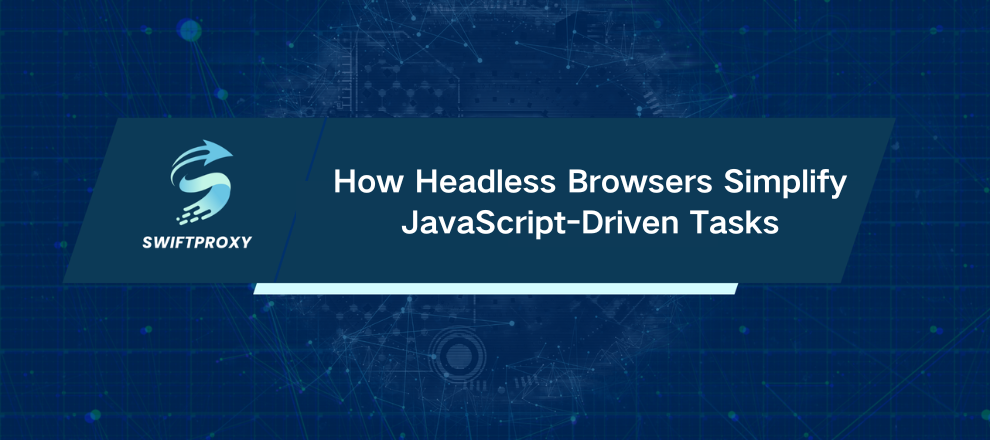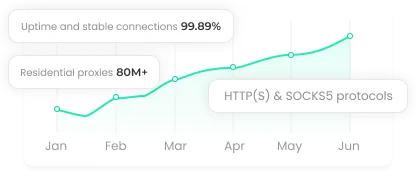How Headless Browsers Simplify JavaScript-Driven Tasks
Headless browsers run in the background without opening a window or showing a GUI, yet they can interact with websites just like a human would. They quietly power web scraping, automation, and site testing—streamlining workflows, saving resources, and taking the hassle out of repetitive tasks. In this article, we'll break down what headless browsers are, how they operate, the challenges you might face, and how tools like Swiftproxy can supercharge your scraping efforts.

What About Headless Browser
A headless browser is exactly what it sounds like—a browser without a visible interface. No windows. No buttons. No menus. Instead, it runs in the background, fully controllable via scripts or command lines.
Despite the lack of a GUI, it behaves just like a normal browser. It clicks buttons, fills forms, navigates links, and renders JavaScript-heavy pages. The result? Faster execution, reduced system overhead, and the ability to handle large-scale automation tasks that would grind a regular browser to a halt.
Developers love headless browsers for automation testing, performance monitoring, and especially data scraping. They provide the speed and efficiency that modern web operations demand.
Practical Uses of Headless Browsers
Headless browsers are versatile tools. Here's how they're typically used:
1. Web Scraping
Dynamic pages? No problem. Headless browsers can render JavaScript, simulate user behavior, and bypass most anti-scraping defenses. They make collecting product details, prices, reviews, and other dynamic content smooth and reliable.
2. Automation Check
Want to test a new feature across multiple browsers? Headless browsers let developers simulate real user interactions at lightning speed. From form submissions to button clicks, they help ensure that web apps behave exactly as intended.
3. Website Monitoring
Headless browsers can keep an eye on web pages, detecting changes and automating actions when needed. This is perfect for pricing updates, content changes, or monitoring competitor activity.
Top Headless Browsers You Should Know
1. Puppeteer
Built on Chromium, Puppeteer gives developers precise control over web pages using JavaScript. Screenshots, PDFs, scraping—Puppeteer handles it all.
2. Selenium
Selenium isn't just for testing—it supports multiple browsers in headless mode, making it suitable for automation and scraping tasks alike.
3. Playwright
Developed by Microsoft, Playwright handles Chromium, Firefox, and WebKit. Cross-browser support is its superpower, making it ideal for modern web apps.
4. PhantomJS
Once a go-to tool, PhantomJS is now legacy but still finds use in older projects. Quick, lightweight, and GUI-free, it paved the way for today's frameworks.
How Headless Browsers Scrape the Web
Scraping with headless browsers follows a straightforward process:
Open the Browser
const browser = await puppeteer.launch({ headless: true });
Go to the Target Page
await page.goto('https://example.com', { waitUntil: 'networkidle2' });
Extract Data
Grab text, images, form inputs—whatever you need.
Automate Actions
Simulate clicks, scrolls, and form submissions to get deeper data.
Save the Data
Store it locally or push it to your database for analysis.
Challenges You Might Face
Even the best tools have hurdles.
1. Anti-Scraping Defenses
IP blocks, CAPTCHAs, and rate limits are common. Headless browsers can mimic human behavior, but advanced security may still catch them.
2. Dynamic Content
Modern websites rely heavily on JavaScript. Rendering speed, network delays, and script execution can impact scraping accuracy.
3. Website Changes
Layouts evolve, and scripts can break. Regular maintenance is essential for consistent results.
Boost Your Scraping with Swiftproxy
Headless browsers are powerful, but combine them with Swiftproxy's high-performance residential proxies, and you can bypass anti-scraping mechanisms, rotate IPs seamlessly, and collect data without interruptions. Efficiency skyrockets, and your scraping operation becomes virtually unstoppable.
Conclusion
Headless browsers aren't just tools—they're engines of efficiency. Master them, pair them with the right proxies, and web automation becomes a precise, powerful, and surprisingly elegant operation.

















































